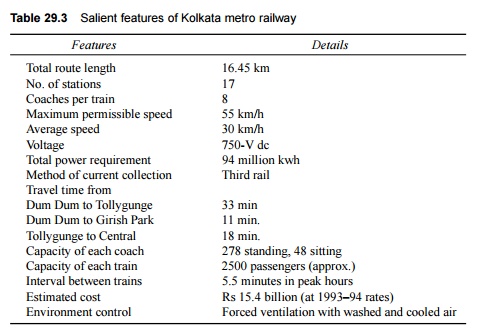Chapter: Civil : Railway Airport Harbour Engineering : Railway Engineering : Suburban Railways in Metro Cities
Kolkata Metro Railway
Kolkata Metro
Most of the suburban traffic in
Kolkata is borne by Eastern Railways for distances extending to over 100 km. On
the South-Eastern Railway, the suburban sections extend from Howrah to
Balichak, which lie at a distance of 92 km from each other. The railway system
in Kolkata terminates at Howrah on one side and Sealdah on the other, both of
which lie on the periphery of the central business district of Kolkata. In view
of this, commuters have to cover the distances within the city by other modes
of transport or on foot.
City buses carry a major portion
of commuters from one place to another place. Besides the suburban rail and bus
transport services, the tramways are an important mode of mass transport system
in Kolkata. The Kolkata Tramway Company has about 400 trams. The underground
metro railway in Kolkata started functioning from 24 October 1984 between
Esplanade and Bhawanipore. It stretches from Dum Dum to Tollygunge and covers a
route length of 16.45 km. The construction work of this underground railway was
done by the cut and cover method in the open area. However, the driven
shield tunnelling method was adopted wherever the metro alignment passed
under residential buildings or a canal.
1 New Technologies used in Kolkata Metro
The construction of a metro is of
a very complex nature requiring the application of several new technologies in
the fields of civil, electrical, signalling, and telecommunication engineering.
For the first time in India, engineers, backed by their own experience and
supplemented by the knowledge gained through their studies abroad, have
incorporated the following advanced technologies with regard to the
construction of the Kolkata metro.
(a) Cut and
cover method of construction using diaphragm walls and sheet piles.
(b) Use of
extensive decking to keep the traffic flowing over the cut while construction
was in progress underneath.
(c) Shield
tunnelling using compressed air and airlocks.
(d) Integration
of a ballastless track using elastic fastenings, rubber pads, epoxy mortar, and
nylon inserts.
(e) Air
conditioning and ventilation system for controlling the atmosphere of stations
and tunnels.
(f) Third
rail current collection system for traction.
(g) Underground
substations with dry-type transformers and SF-6 circuit breakers.
(h) Continuous
automatic train control system.
(i) Tunnel-train
VHF-radio communication system.
(j) Train
control and supervisory remote control systems fitted with microprocessors for
substations.
(k) Automatic
ticket vending and checking system.
2 Benefits of Kolkata Metro
The Kolkata metro, like all other
mass rapid transit systems in the world, cannot be financially remunerative, as
subsidies are inevitable in the operation of such an expansive system. However,
introducing a system that covers the entire city has resulted in the following
benefits to the public.
(a) The
social benefits of the Kolkata metro far outweigh the burden of the subsidies.
(b) It
carries more than 0.5 million commuters per day in trains that follow each
other at intervals of about 5 min during the peak hours.
(c) The
commuters are assured of a pollution-free, safe, punctual, and comfortable
journey.
(d) Commuting
time is drastically reduced.
The
salient features of the Kolkata metro are listed in Table 29.3.
Table 29.3 Salient features of
Kolkata metro railway

The expansion of the Kolkata
metro is also being planned. The detailed project report for the East-West
corridor from New Dass Nagar to Salt Lake Sector 5 has been submitted to the
State Government by the DMRC. The corridor is 16 km long with 9 km of
underground section. An interchange has been proposed for the crossing of the
N-S line at Central Station. The corridor will pass below the Hugli river at a
depth of about 30 m from the ground level.
Related Topics